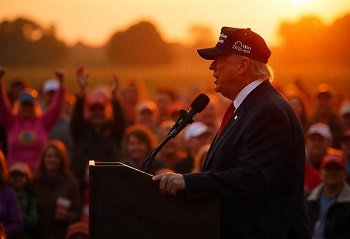White House Justifies High Tariffs Amidst China’s Retaliatory Measures
In a major development in global trade, former US President Donald Trump has increased tariffs on Chinese imports to 245%, citing unfair trade practices and retaliatory actions by China.
This massive tariff spike, up from 145%, marks a turning point in the ongoing US-China trade war, and is aimed at safeguarding American economic interests.
Key Highlights of the Tariff Hike

- Tariffs on Chinese imports raised to 245%
- Previous tariff rate stood at 145%
- White House cites China’s retaliatory measures as justification
- Over 75 countries reportedly in talks with the US for trade agreements
- Trump’s protectionist approach reshapes global trade dynamics
What Led to the 245% Tariff Hike on Chinese Goods?
The White House fact sheet, released recently, mentions that China’s retaliatory actions have directly led to this move.
According to officials, the previous tariffs were insufficient to counteract the economic impact caused by Chinese import restrictions and subsidized exports.
Background of US-China Tariff Conflict
- The US-China trade war began during Trump’s presidency as a push to reduce the massive trade deficit with China.
- Trump initially imposed tariffs on steel, aluminum, and electronics.
- China responded with its own tariffs, targeting American agriculture, automotive, and tech sectors.
Trump’s Economic Agenda: Protecting American Industry
President Trump has long emphasized “America First” policies. His tariff strategy has aimed to:
- Protect US manufacturers from unfair competition
- Encourage domestic production
- Deter countries from exploiting US trade policies
According to the White House, these tariffs are reciprocal and strategically imposed to balance trade relationships.
Temporary Pause and Ongoing Trade Negotiations
Following initial tariff announcements, Trump introduced a 90-day pause to allow time for trade negotiations. During this period:
- Multiple countries initiated dialogues with the US
- More than 75 nations expressed interest in revisiting trade terms
- Trump administration focused on bilateral agreements over multilateral ones
“We are open to fair trade, not free trade that disadvantages the American worker,” a senior White House official stated.
China’s Retaliatory Measures: Catalyst for Aggressive Tariffs
The sharp 245% hike was not implemented in isolation. China had reportedly:
- Increased import restrictions on US-made goods
- Raised tariffs on critical American exports
- Imposed non-tariff barriers through regulatory challenges
These actions have cost the US billions in potential exports, leading to a stronger retaliatory response.
Sectors Most Affected by the New Tariff Rates

1. Technology and Electronics
- Smartphones, laptops, and semiconductors will see price hikes
- Companies dependent on Chinese components face cost pressures
2. Automotive Industry
- Chinese car parts and electric vehicle (EV) batteries to become more expensive
- US automakers may face production delays and cost increases
3. Consumer Goods
- Items such as clothing, furniture, and toys likely to become more expensive for US consumers
Implications for the Global Economy
This move by the US could have wide-reaching effects across global markets:
- Global supply chains may shift to alternative Asian countries like Vietnam, India, or Indonesia
- Investors may witness market volatility due to uncertainty in US-China relations
- Other countries may reconsider their own trade alignments in response
Expert Opinions on Trump’s Tariff Hike
Economists are Divided
While some economists believe this move is necessary to counteract unfair Chinese trade practices, others worry about:
- Inflationary pressure in the US economy
- Potential slowdown in global trade
- Rising costs for American businesses and consumers
Political Analysts Weigh In
Political experts suggest that this tariff hike may also be part of Trump’s 2024 campaign strategy, reinforcing his image as a strong leader on economic issues.
Impact on India and Other Emerging Economies
With the US and China at odds, India may stand to gain:
- Increased interest from American companies to diversify supply chains
- Opportunities for Indian exports to fill the gap left by Chinese goods
- Potential for US-India trade agreements to be fast-tracked
What’s Next? Global Trade Trends to Watch
The Trump administration has hinted at:
- Reviewing existing free trade agreements (FTAs)
- Continuing to monitor countries with high trade surpluses
- Promoting domestic manufacturing incentives
As the trade landscape evolves, countries worldwide are reassessing their economic partnerships and trade policies.

Conclusion: A Bold but Risky Move
Donald Trump’s decision to raise tariffs on Chinese imports to 245% is a bold step with significant geopolitical and economic implications.
While the White House believes this is a necessary move to protect American interests, the true impact will unfold over the coming months as trade negotiations continue and global economies react.





